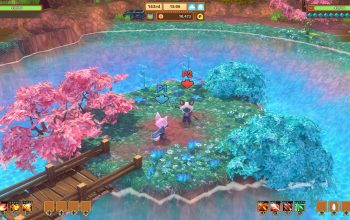
Treasure chests are basically a roulette. This doesn’t even address the fact that the game is littered with copper, silver, and gold treasure chests everywhere that require one to mine ore, turn it into ingots, and pay a hefty sum (plus an iron resource) to make one key. Equipment upgrades are necessary, but if players want to explore everything else the game offers-like eating the food they pay to have cooked-then the grind becomes even worse. Since players can only hope to double their money after paying for all of the seeds and cooking, affording any crafts or upgrades becomes an exercise in tedium or futility. This system is one of the most egregious forms of grinding in Kitaria Fables. Not only do seeds cost too much, but turning basic produce into a meal worth selling eats into profits. That’s fine, but only if it’s an actual strong source of money and if it’s interesting in any way.

The supposed draw of the farming component of Kitaria Fables is that this is your income. Money is probably the biggest hurdle, with most weapon or armor upgrades costing an excessive amount.īehind that cute exterior lies a horror unknown to most mortal men. The entirety of progression is housed in item drops, typically consumable or craftable. Most of Kitaria Fables devolves into watching for the red cone or circle warning of an enemy attack, dodge roll, then counter with a spell or swing. The four shoulder buttons on controllers allow the use of the occasional spell or weapon ability, which depletes a renewable mana resource using weapon attacks (swords or bows). The difference here is a minute or two of walking and rolling through enemy attacks in the field, but this adds up over time and could be easily solved with a better teleport mechanic.įrom a top-down perspective, players navigate the world with relative ease committing attacks and dodge rolls with the touch of two buttons. Rarely are teleport crystals offered outside of towns. The bulk of Kitaria Fables takes place in a humble village adjacent to the protagonist’s father’s home, serving as the “farm.” From here, the player can warp around to different locations that have teleport crystals, but can only use the ones in the wild as checkpoints or one-way destinations.

In today’s context, there’s simply no excuse. Vacant modern quality of life game design or conveniences, Kitaria Fables feels like an “eh” game from two decades ago. What’s horrific isn’t the story, but the entire experience.

What’s behind this disturbance? Play to the end of the horrific adventure to find out. The land has already been cleansed of evil, but for some reason, monsters continue to harass villagers and do-gooders. Kitaria Fables follows a nameless protagonist and his anthropomorphic pink cupcake-like companion. Kitaria Fables is more action RPG with a touch of agriculture-just a touch.
KITARIA FABLES ROMANCE OPTIONS SIMULATOR
At this point, farming simulator games are a mix between life sim, action RPG, and agricultural activities. Unfortunately, options are limited, with the only real competitors being My Time at Portia (passable) and about fifty Farming Simulator games, which are a more realistic departure from the genre. About two decades later, enter Stardew Valley, and the farming sim genre goes from obscure to baked into every Tesla. Farming sims became a cult hit when Harvest Moon debuted on the SNES in 1996/1997.


 0 kommentar(er)
0 kommentar(er)
